The Samsung Galaxy S6 and S6 edge Review
by Joshua Ho on April 17, 2015 9:00 AM EST- Posted in
- Smartphones
- Samsung
- Mobile
- Galaxy S6
- Galaxy S6 Edge
System Performance
In order to test the Exynos 7420 and the phone in general, we turn to our suite of benchmarks which are able to show how the device performs in common general computing workloads. Something as simple as web browsing is still surprisingly intensive on mobile phones, and in general Android can often be quite stressful to run in the constraints of a ~3W total TDP especially on any phone still running Dalvik due to its strong reliance on bytecode and a virtual machine that translates bytecode to machine code just before and during application runtime. ART improves this significantly, but is limited in the nature of optimization as AOT compilation optimizations are limited by the CPU power of the SoC and the need to compile the application in a reasonable amount of time.
As always, we'll start things off with our browser benchmarks. After getting to use the phone, it became clear to me that Chrome is poorly optimized against the Galaxy S6 as Samsung’s browser is clearly superior in performance. For that reason I've gone ahead and run our benchmarks on both Chrome and on the stock browser, as seen below.

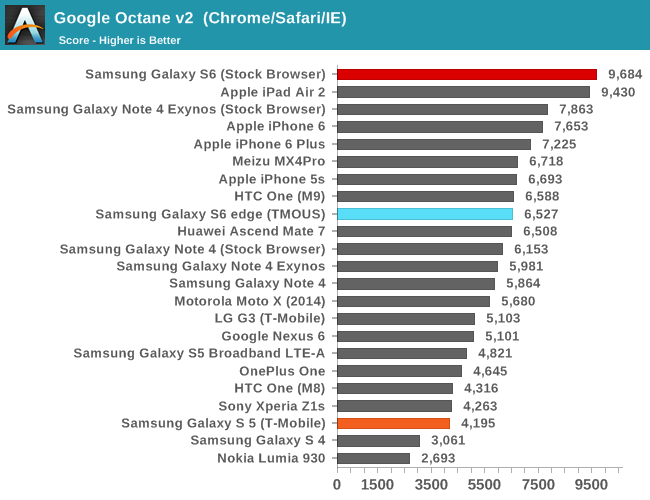

Needless to say, in order to see the full potential of the Exynos 7420 and its cluster of A57s, it’s necessary to use Samsung’s stock browser. This performance is really quite amazing when compared to Apple’s A8X, which has basically been the gold standard for performance in the mobile space in the context of ARM SoCs.
Moving on, as a part of our updates to the benchmark suite for 2015, we'll take a look at Basemark OS II 2.0, which should give a better picture of CPU performance in addition to overall device performance.
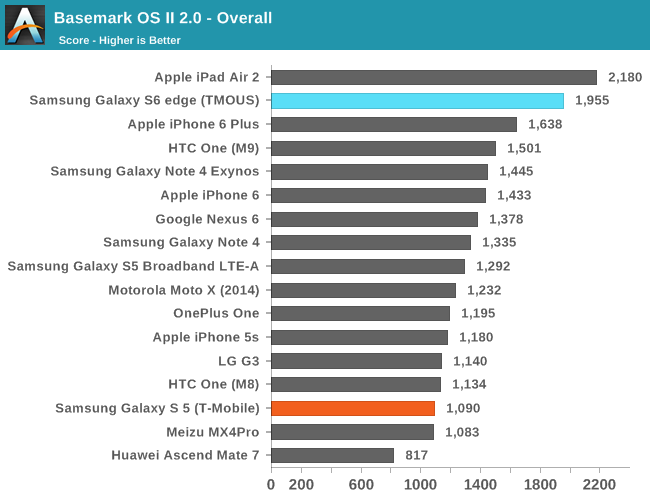
The browser benchmarks seem to hide some pretty enormous variability as the Galaxy S 6 edge (which is comparable to the Galaxy S 6) sets a new record among Android devices. The only challenger is the iPad Air 2, which uses the A8X SoC with three Enhanced Cyclone cores and the semi-custom GXA6850 GPU.
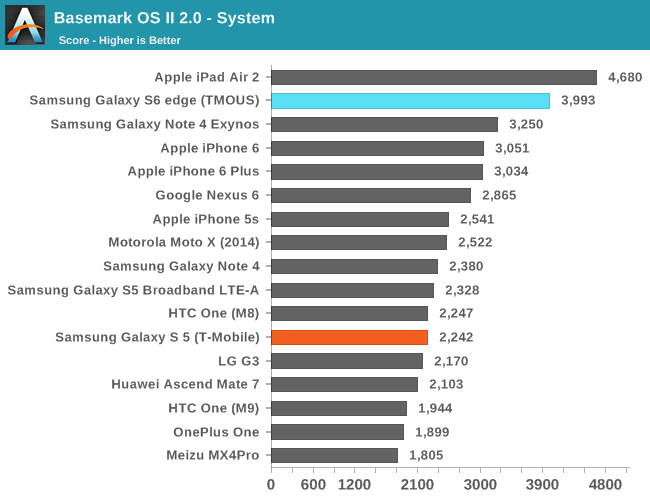
This system test contains a floating point and integer test, in addition XML parsing, which means that this test mostly stresses CPU and RAM. Interestingly enough, the Exynos 7420 pulls far ahead of both the Exynos 5433 and Snapdragon 810 in this test, and approaches the A8X. The difference between the 5433 and 7420 is likely a combination of the higher clocks on both the A57 and A53 clusters for the 7420 (1.9/1.3 on the 5433, 2.1/1.5 on the 7420), in addition to the ability to stay at a high 'overdrive' clock due to reduced leakage from the 14LPE process. The One M9 likely falls a bit short here due to HTC's governor settings restricting the use of all 8 cores simultaneously.

While one might guess that the memory test of 'Basemark OS II 2.0 - Memory' is of RAM, this is actually a test of the internal storage. Once again we see the S6 edge come close to leading the pack due to the use of the new UFS (Universal Flash Storage) standard. Casual examination reveals that the S6 edge has a queue depth of 16, and that it identifies itself with the rather cryptic model name of KLUBG4G1BD-E0B1.
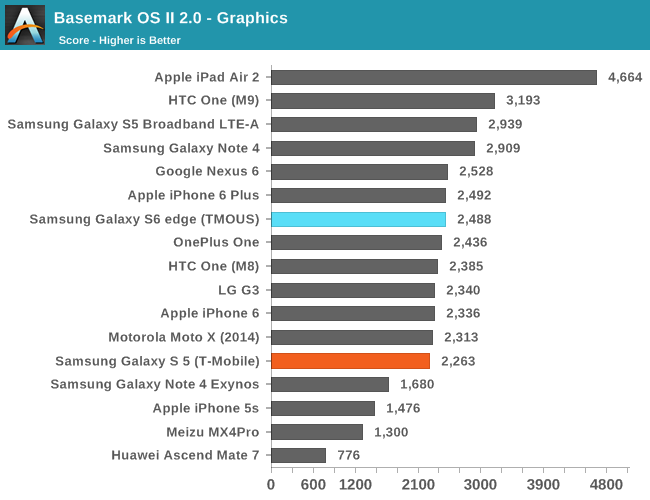
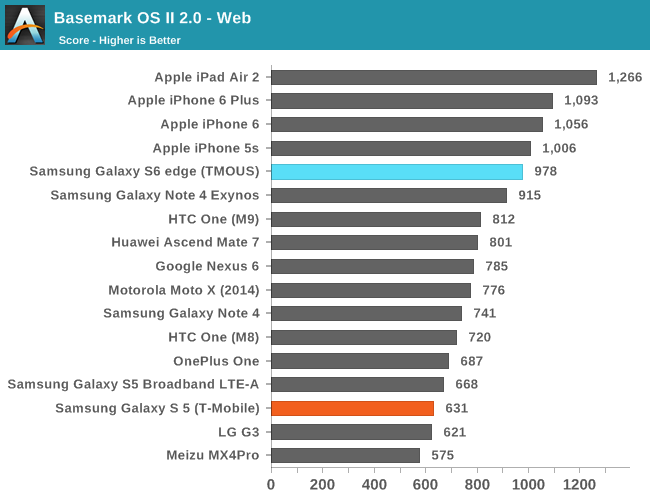
For the web test, it uses the built-in WebView rendering engine rather than Chrome and paints a distinctly different picture, especially because these tests are focused on HTML5 and CSS rather than JavaScript. Here we can see that the iPhone 6 and iPad Air 2 continue to hold their lead, but the Galaxy S6 is pretty much the king of the hill when it comes to Android devices.
Our next system benchmark is PCMark, which does a number of basic benchmarks designed to stress various aspects of the device in everyday workloads like video playback, web browsing, text editing, and photo editing. This tends to test every aspect of a mobile device, unlike microbenchmarks that can often miss aspects of the system that can affect performance.
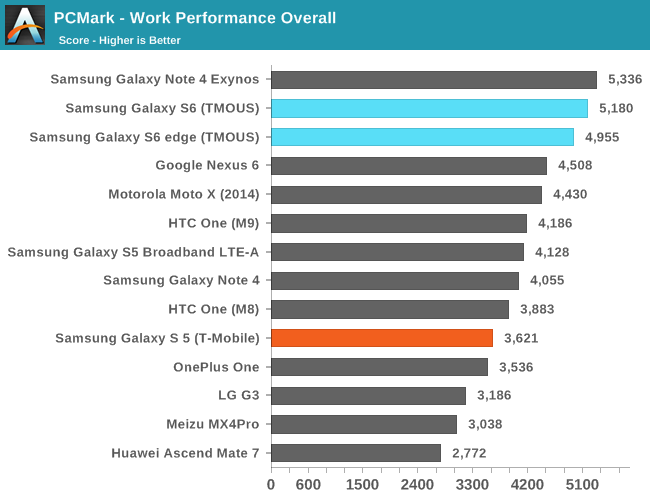
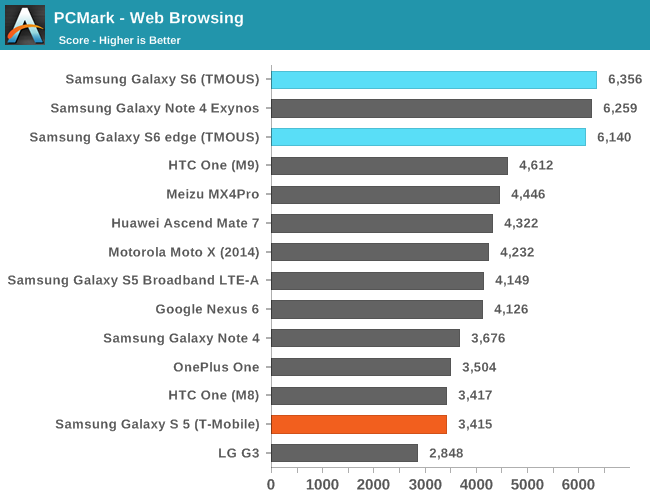
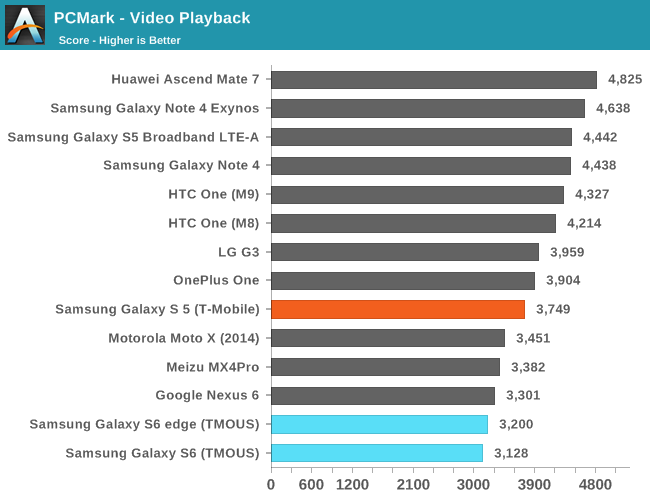
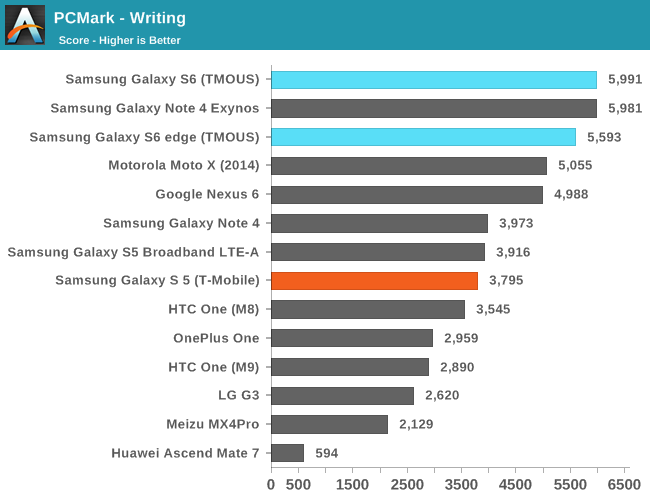

In these tests, the Galaxy S6 continues to perform strongly here due to the fast NAND storage solution and the Exynos 7420 SoC. As we have already covered the Basemark OS II 2.0 results in previous articles, I would refer back to it as those scores are final and have already been contextualized.
Overall, in these general purpose computing tasks that stress CPU, memory, and NAND performance we can see that the Exynos 7420 is off to a flying start. Samsung Mobile should focus more strongly on optimizing the software stack against Chrome as mobile Chrome has around twice the user share of stock Android browsers. I often say that the SoC is the foundation to a good smartphone, and in the case of the Galaxy S6 it feels like this is especially true.










306 Comments
View All Comments
FlushedBubblyJock - Friday, April 17, 2015 - link
That's what happens when "brainy", stuck up, clueless, unoriginal nerds, have no GF's and get their "feel ups" off their cellphone."Oh she feels so cheap !" " She should feel better in my hands"...
Thus, we now have the whined for apple crap.
mkozakewich - Friday, April 17, 2015 - link
that feel when no sdFickleBJT - Saturday, April 18, 2015 - link
Would you buy a car that looked like it was made out of plastic?Remember, these are ~700 dollar phones. Asking for good materials and workmanship is perfectly reasonable. I used to own a GS3 and the paint started coming off of it after just a few months. It made the phone look awful. I would much rather have a nicer feeling and looking phone. Granted, they could have put an SD slot in there, at least in the normal variant.
loki1725 - Saturday, April 18, 2015 - link
"Would you buy a car that looked like it was made out of plastic?"Yes. If you've bought a mainstream car in the last ten years, it probably does have plastic in it.
Would you buy a car where the body was made of glass?
lilmoe - Saturday, April 18, 2015 - link
That's just a bad analogy bro...Kvaern2 - Sunday, April 19, 2015 - link
The analogy is bad yes but his point is nevertheless valid.akdj - Sunday, May 31, 2015 - link
Not really, not when some of the best, fastest and finest cars in the world are made from plastics, 'glasses' (plexi, etc) & carbon fibermaxxbot - Wednesday, April 22, 2015 - link
So "nerds" are the driving force between Samsung and Apple's huge sales numbers? There sure must be a lot of "nerds" out there.FlushedBubblyJock - Friday, April 24, 2015 - link
Pride, ego, status, selfie love.Spend the big bucks for the premium status symbol, then others will love you too.
I really don't think nerd is any part of the equation - clueless herd sheeping seems to be the case.
Margalus - Friday, April 17, 2015 - link
just the opposite for me. no removable sd card is a non issue with the base model having 32GB, and 64 and 128GB models available. But no removable battery with android is a show stopper. What good is a "mobile" phone if it goes dead in 4 hours while you are out and can't charge it?as for the sd card, my s4 has 9.5GB or internal and a 64GB external sd. All together I have used up about 30GB of storage over 2 years.. so a 64GB or 128GB model would be fine without an external sd card. But with a dead battery and no way to replace it, the phone is useless.